Although both Jim and I have visited the USOC training
center in Colorado Springs previously, it's
been long enough that we decided to take another tour this week. There
are many new exhibits, sculptures, and buildings on campus since we were there in the '80s and '90s,
and the current slogan, "Amazing Awaits," is different.

This was the first of three major Olympic training centers
built in the United States and it has housed the US
Olympic Committee offices since 1978. The other two main campuses with training
facilities for our athletes are in Chula Vista, CA and Lake
Placid, NY.
The training complex in Colorado Springs was formerly part of
Ent Air Force Base and headquarters of the North American
Defense Command. When they relocated, the site was chosen by the USOC in part
because of its relatively high altitude (about 6,500 feet),
which can increase the effectiveness of the athletes' training.
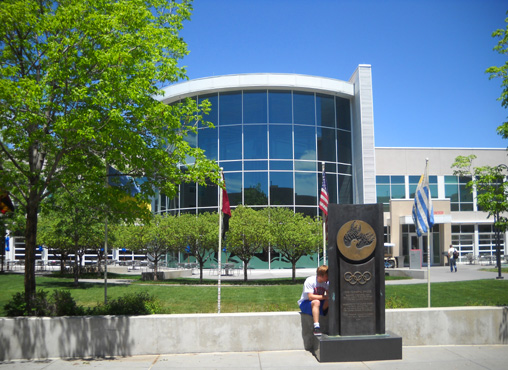
It was probably also a good financial deal for the USOC.
Some of the existing buildings were remodeled for use by the
athletes and others have been added over the last three decades.
Major additions in the late '90s were a state-of-the-art sports
medicine/ sport science center and an athlete center with
a large dining room and two residence halls (photo above).
Other facilities include a large visitor center,
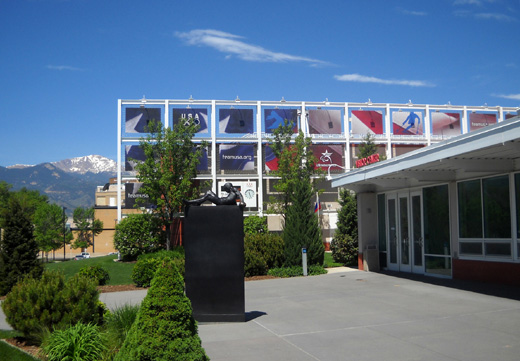
Countdown clock near entrance, below center: 789
days to London, 1349 days to Sochi
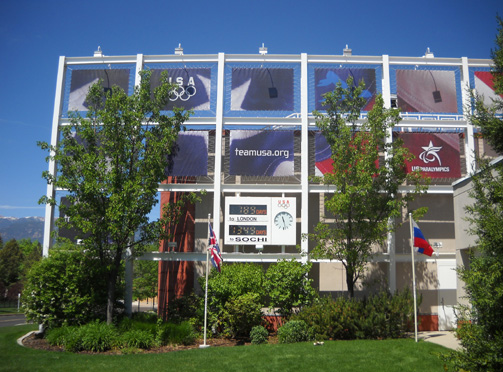
offices for the USOC and two dozen member organizations, an
Olympic-size swimming pool (duh!),
two sports centers with numerous gyms and weight rooms,
a velodrome, and an indoor shooting range.
WHO TRAINS HERE?
According to the USOC website the complex at
Colorado Springs is able to provide housing, dining,
recreational facilities, and other services for up to 557
coaches and athletes at one time. They come from all over the
United States and represent a variety of sports, including
triathlon, modern pentathlon, fencing,
weight-lifting, wrestling, swimming, diving, cycling, shooting,
women's volleyball, and men's gymnastics.
Athletes who are training for the Olympics, Paralympics, or
Pan-Am Games can live at the complex for several months or even
years. Anywhere from 100 to 230 athletes live and train
at the center on a full-time basis. While each sport's national
governing body manages all coaching support for its athletes, the USOC provides elite athletes with housing and food, training
facilities, sports medical care, sports science testing and
analysis, local transportation, recreational facilities and
activities, and professional development at an estimated annual
cost of approximately $25,000 per athlete. The average age of
full-time resident athletes is 24, although the range has been
from 15 to 40 years old.
Up to 10,000 other athletes come for shorter periods of time
each year with their specific teams for training camps,
coaching, and/or physical testing. That's a bunch!
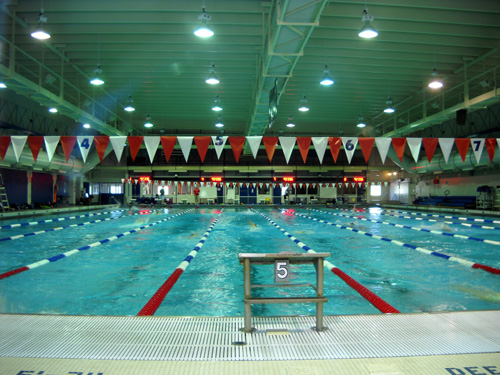
Our tour guide emphasized that the USOC centers do not receive
any government funding for the athletes, staff, or facilities.
Funding comes from generous corporate sponsors,
the various sports foundations, and donations.
We were given several subtle opportunities to make a donation,
but the sales pitch wasn't heavy.
As Jim and I toured the impressive facilities, we agreed that we
wouldn't mind some of our tax dollars going to support
the athletes. In our opinion there are many, many ways the
government wastes our taxes; we see this as one of the
more legitimate ways to spend it.
But that's just our perspective as folks who value physical
fitness more than the average citizen does.
VISITING THE TRAINING CENTER
The 37-acre training center is easy to find at 1750 E. Boulder
Street in eastern Colorado Springs. Guided tours are offered Monday to Saturday from 9-4.
The tours and on-site parking are free.
As you've seen in the photos above, the entrance to the visitors' center is very attractively
landscaped with plants and sculptures, including the riveting
"Olympic Strength" sphere:
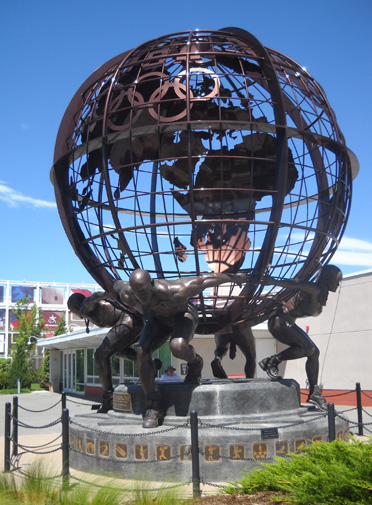

This sculpture of a female skater, entitled, "The Juliet," is a
tribute to (and was unveiled by) Olympic figure-skating gold
medalist, Kristi Yamaguchi:
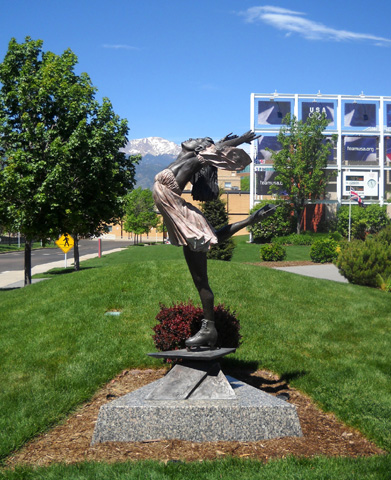
There are several other sculptures near the entrance that I
haven't included here.
Visitors, staff, and athletes also have beautiful views of
Pike's Peak from the entrance and various points around campus:
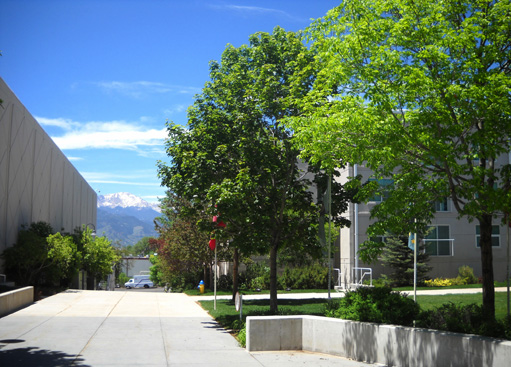
THINGS TO SEE INSIDE THE VISITOR CENTER
When Jim and I visited we had about half an hour's wait until
the next tour began. We used that time to browse through the
exhibits and sports art displayed in the hallways and the large
Hall of Fame room, to check out the official Olympic apparel and
merchandise for sale, and to wander around the outdoor pond and
flag display.
One of the first displays that caught my eye was a case with a
1996 Olympic torch and other memorabilia. I still consider those
"my" Games.
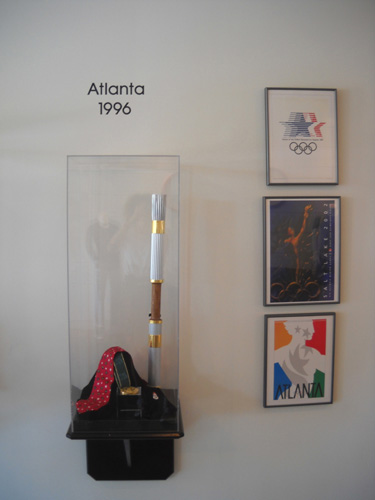
No, I was never an Olympic athlete but I had the honor of
carrying the torch in Stone Mountain the night before the opening ceremonies
as it was paraded through the Atlanta metro area. I still have my torch, the clothes I wore to carry it,
all my
volunteer clothing, pins, posters, other memorabilia --
and many great memories -- from those Games. Those three weeks
were one of the high points of my life.
Jim was quick to spot this case with the 1984 Olympic torch from
the Games in Los Angeles:
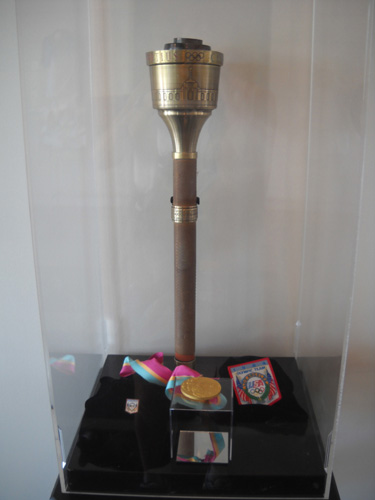
Those Games have special memories for him because he had the
honor of carrying a torch just like that one when it went
through Springfield, IL. Back then carrying the torch was
much simpler than it was in 1996. There was no application and
nominating process, carriers couldn't keep or purchase their
torches, and Jim didn't get a special outfit to wear. His
running club invited anyone who wanted to carry the torch to
just show up on schedule, and Jim got to carry it for about a
block.
Although the application/nominating process in 1996 was more
complicated and stressful (i.e., waiting to see if I was chosen
to carry the torch and/or volunteer every day of the
Games), I'm glad I have the tangible memorabilia as reminders of
that time.
Some of us are bigger pack rats than others!
Continuing past the welcome desk and down another long hallway
are many other photos and displays from previous Olympics. The
names of the American participants in each Olympics are listed
on one wall.
Large windows look out on pretty ponds, more beautiful
landscaping, and the Olympic Pathway.
Near the back doorway of the visitor center is a theater where
tour groups meet and a large room with banners, murals, and
sculptures honoring the athletes who have been inducted into the
US Olympic Hall of Fame:
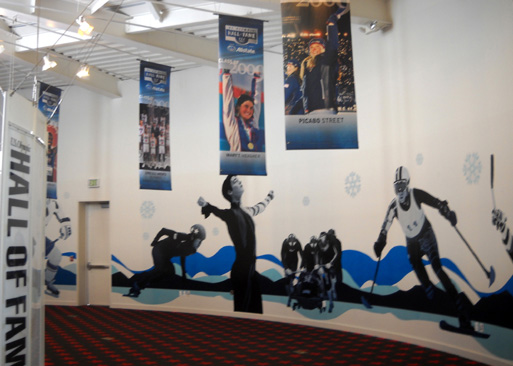
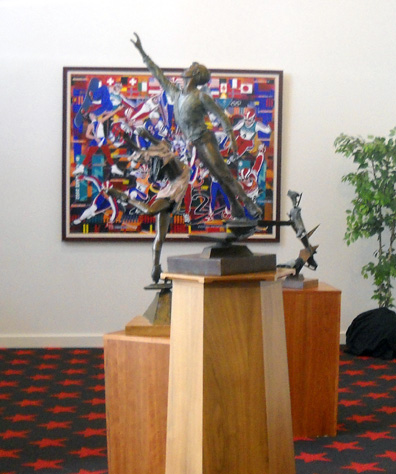
Here are the inductees from 1983, which I'm guessing was the
first year the honor was bestowed:
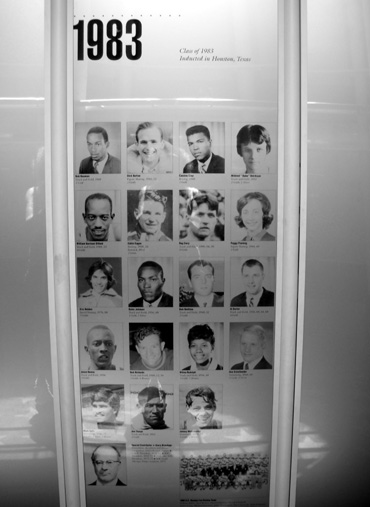
The most recognizable gold medalists inducted that year include Bob Beamon (Track & Field,
1968), Dick Button (Figure Skating, 1948, 1952), Cassius Clay
(Boxing, 1960), Mildred "Babe" Didrikson (Track & Field, 1932),
Peggy Fleming (Figure Skating, 1964, 1968), Eric Heiden (Speed
Skating, 1976, 1980), Al Oerter (Track & Field, 1956, 1960,
1964, and 1968!), Jesse Owens (Track & Field, 1936), Wilma
Rudolph (Track & Field, 1956, 1960), Mark Spitz (Swimming, 1968,
1972), Jim Thorpe (Track & Field, 1912), and Johnny Weissmuller
(Swimming, 1924, 1928).
Wow. What an illustrious group! So are the other years'
inductees.
THINGS TO SEE OUTSIDE
You can see all those things inside (plus a film and the
Olympic store) without participating in a guided tour, but we
highly recommend joining a tour group to benefit the most from
your visit.
Outside (behind) the visitor center, guests may view the banners, go up
some stairs to see the Olympic cauldron, and walk along the
Olympic Pathway but they may not enter any of the buildings or
wander around other areas without an escort. We did walk
around outside in the public area for a few minutes before our tour began.
The next photo looks back at the visitor center from part way
down the Olympic Pathway, which is lined with colorful flags of
200+ nations. The cauldron is in
the center of the picture at the top of the stairs:
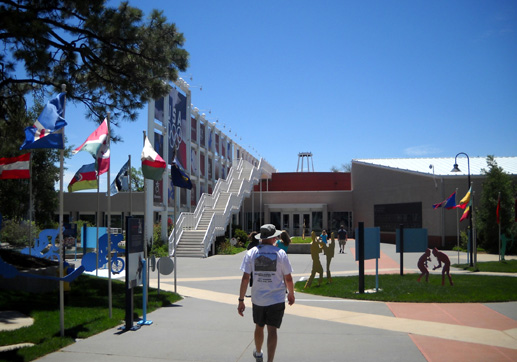
The next three photos show areas just outside the back doors of
the visitor
center.
This is the view toward the Olympic Pathway and the other
buildings in the complex. All
along the Pathway are silhouettes of athletes
in various sports, such as the speed skater crouched down below left:
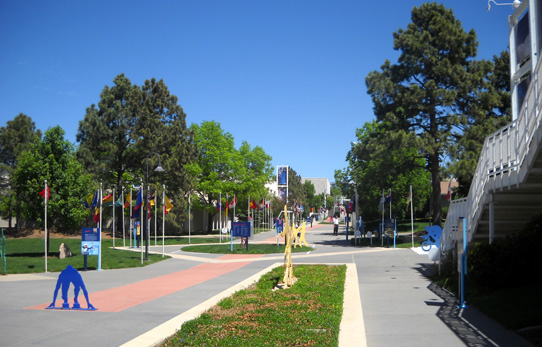
My favorite place outside was near the ponds that you can also see from a wall of
windows inside the visitor center. I walked around the ponds to
get these and other photos before joining Jim in a shady spot to wait for
our tour.
The wall of banners extends several hundred feet from the street
side
of the visitor center (shown in several of the photos farther up in this
entry), along the side, and behind the building:
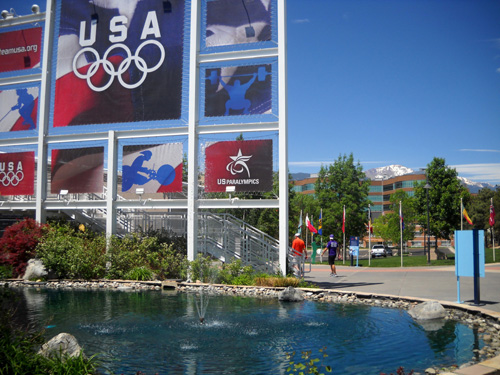
Here's another angle:
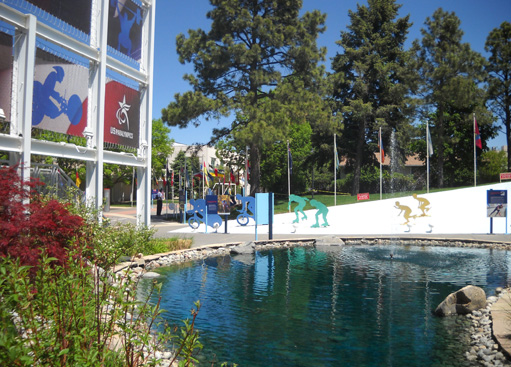
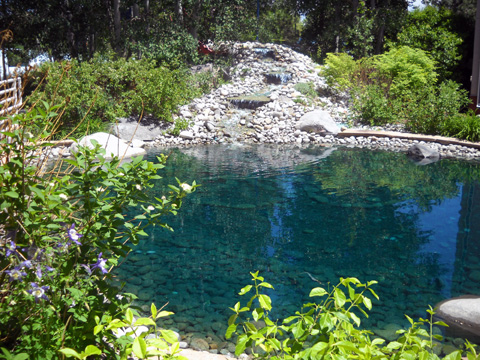
That was an ideal spot to wait for our tour to begin. Ahhh .
. .
THE GUIDED TOUR
Folks wanting to join the next guided tour were instructed to
meet in the theater at the appointed time. That day tours were
scheduled about 30 minutes apart.
Our tour began with an inspiring Olympics/Paralympics highlights
film in the comfortable theater, then proceeded outdoors for a
walk down the Olympic Pathway (below) and through the complex.
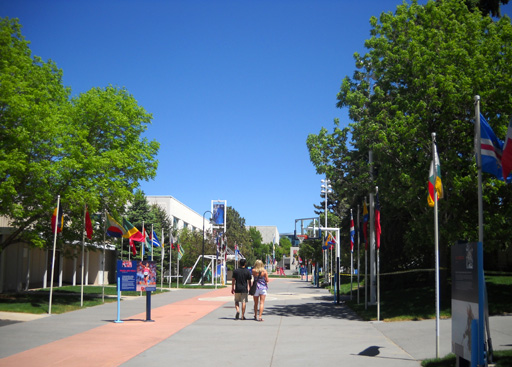
We were able to see inside part of the sport science/sports
medicine building, below,
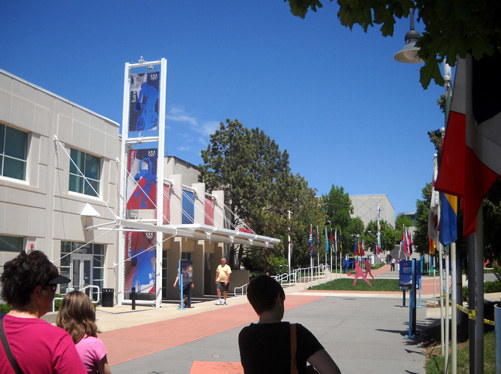
part of a multi-purpose gym that wasn't being used,
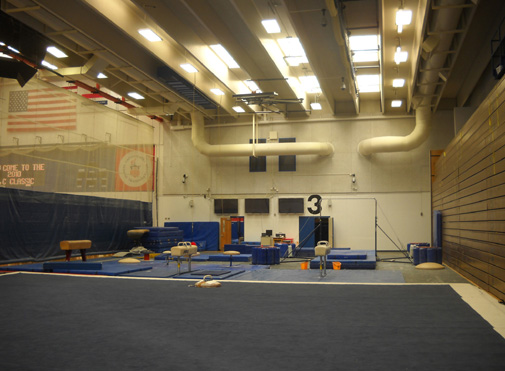
a strength and conditioning room, and the pool (shown farther
above).
Kathleen, our tour guide, was knowledgeable, articulate, and
knew every athlete who passed our way. She introduced us to
Aaron, for example, a Paralympic cyclist with cerebral palsy who
was returning to his dorm room after receiving treatment for an
injury he'd received during training that morning:
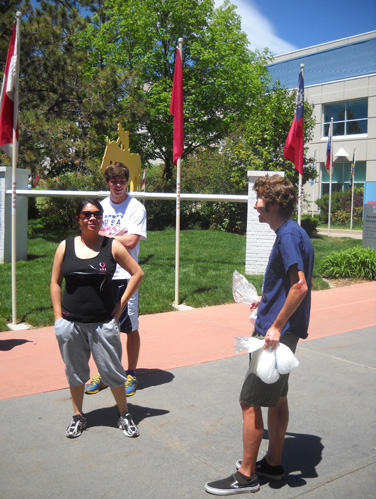
Because our group was large (about fifty people), it sometimes
took a while to shepherd everyone into a building or spot
outside where each person could hear Kathleen talk, but everyone in
the group was mannerly and attentive. A new staff
member-in-training also came along to learn how to lead tours
this summer.
This was one of the quieter corridors where Kathleen had us stop
for a few minutes to talk about various aspects of life on
campus. I stepped away from the group to take this scenic shot
of the colorful flags and Pike's Peak in the distance:
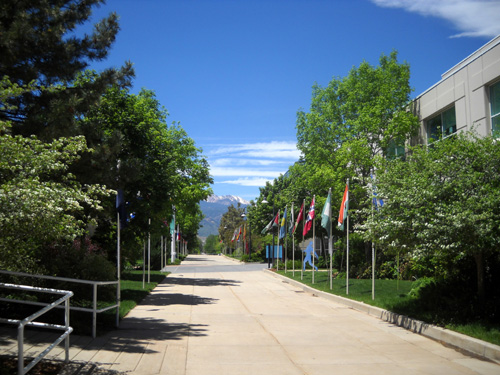
> sigh < That's so idyllic.
After about 45 minutes (including the film at the beginning),
our tour ended next to the Truce Monument in front of the
athlete residence/dining area:
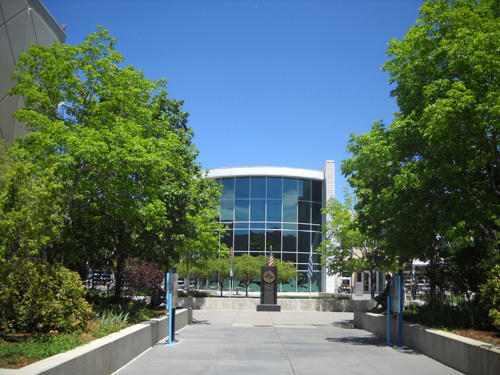
Kathleen talked some more about what the athletes'
activities while living here. Then we were on our own to wander
back the Pathway to the visitor center.
We stopped to read the
inscription on the Truce Monument:
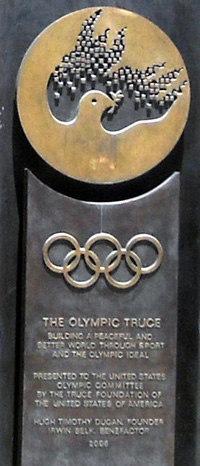
The Olympic Truce: building a peaceful and better world
through sport and the Olympic ideal.
We also read a nearby sign that explains what it's like
for the full-time resident athletes. Besides four to six hours
of training and cross-training each day, many of the young athletes also further
their education at colleges in Colorado Springs and/or participate in community
activities.

As we meandered back to the visitor center we stopped inside a
covered area at the top of the stairs in the photo below to read
some inspirational quotes by various Olympic athletes;
the quotes are painted on the walls.
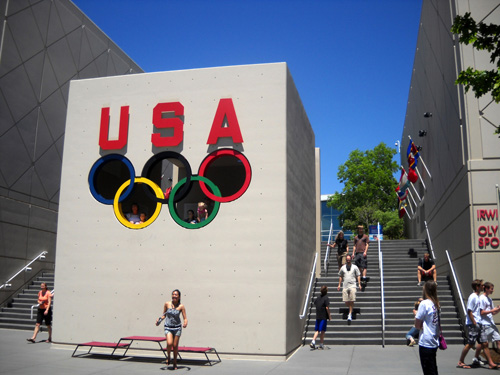
Other visitors peeked through the holes in the Olympic rings or
had their pictures taken on the winners' stands below them.
That's pretty inspirational for kids who aspire to be in the
Olynpics one day!
We were at the training center for a little under two hours and
thoroughly enjoyed it. It was fun to reminisce about athletes
and Games from the past in the Hall of Fame, to observe some
promising athletes who are training for upcoming world
competitions, and to drool over the equipment and medical facilities
available to some of the world's best athletes.
Man, we coulda used some of those rehab services the last 30+
years of endurance running!
In addition, the place is just so gosh darn beautiful. The grounds are very attractive with all
the sculptures, Olympic sports cut-outs, national flags, Olympic
rings and cauldron, ponds, tree/shrubs/flowers/grass, and nice
views of Pike's Peak here and there.
I didn't want to leave! I wanted to be forty years younger and
an elite runner who could live there for several years! (That
sign outside the residence halls says some athletes have lived
there up to ten years!!)
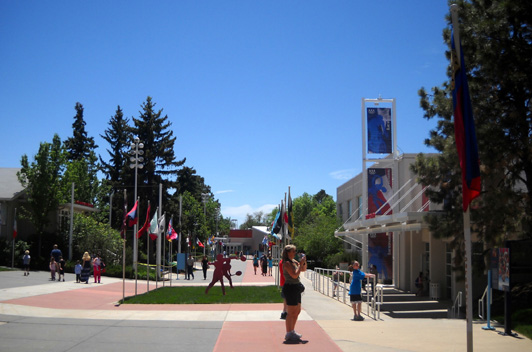
Walking back to the visitor center at the
end of our tour
What a great place to visit -- or train, if you're young,
athletic, and at the top of your sport. Just like when we attended the USAF
Academy graduation, we came out of the USOC training center with renewed pride in
the American youth who represent our
country with honor and dignity.
The Olympic Training Center is one of the most heavily-visited places in the
Colorado Springs area. We recommend you go on a weekday to avoid
crowds, especially during the warm months of the year.
You're also more likely to see athletes training on weekdays
than on weekends. They take some time off for relaxation, too.
For more information, check the
www.teamusa.org website.
Next entry: "Territory Days:" absorbing some
history in Old Colorado City
Happy trails,
Sue
"Runtrails & Company" - Sue Norwood, Jim O'Neil,
and Cody the Ultra Lab
Previous
Next
© 2010 Sue Norwood and Jim O'Neil